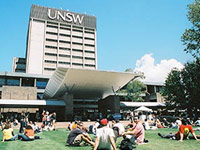| Chemical Eng/Biomedical Eng - 3048 |
|
|||||||||||||||||||||||||||||||||||||||||||

Program Summary
This concurrent degree program is specifically designed for undergraduate students wishing to pursue a career in Biomedical Engineering. This allows students to enter an integrated program which provides both the prerequisite engineering education and the specialist Biomedical Engineering training. Students are expected to perform at a Credit average (65%) or better in their first three years to be permitted to progress to the Masters component of a concurrent degree program. Students who at the end of Year 3, do not satisfy the requirements for progression to the Masters component may complete the Bachelor of Engineering. At the completion of the Bachelor of Engineering, students may enrol in the Graduate Diploma in Biomedical Engineering with advanced standing for the (postgraduate) biomedical courses previously completed. Students may elect at any time to revert to the BE program. If, once entering a concurrent degree program, students wish to revert to the normal BE programs they will need to satisfy the requirements for the BE as set out in the relevant sections of the Handbook. Since the concurrent degree program introduces courses additional to those in the BE, the student reverting to the normal BE program may require up to an additional year to achieve a BE after completing years 3 or 4 of the concurrent degree program.
Program Objectives and Learning Outcomes Please see http://www.eng.unsw.edu.au/rules/
At the end of the 5th year, you will graduate with BE in Chemical Engineering and MBiomedE. The program is based on modified 3040 with additional courses in preparation for Masters.
PLEASE NOTE:
Year 1 (Flexible commenced in 2006)
Choose ONE of:
And ONE of:
And ONE of:
Plus these following 3 courses:
Plus choose 2 Electives from the Year 1 Elective Listhttp://www.eng.unsw.edu.au/rules/elective.htm
Suggested Year 1 electives are:
For information relating to Years 3-5 of the flexible program structure please refer to the school website http://www.ceic.unsw.edu.au
Year 2
For those who enrolled prior to 2006, please refer to the School Website
Year 3
General Education 3 UOC
Year 4
Plus Biomedical Engineering ENG Electives 18 UOC
Year 5
Plus ONE Biomedical Engineering Elective 6 UOC
AND choose:
Or TWO Biomedical Engineering Electives 12 UOC
Biomedical Electives Preferred electives Other electives
General Education Requirements Please see http://www.eng.unsw.edu.au/rules
Please see http://www.eng.unsw.edu.au/rules
Please see http://www.eng.unsw.edu.au/rules
For information regarding fees for UNSW programs, please refer to the following website: https://my.unsw.edu.au/student/fees/FeesMainPage.html
Industrial Experience Requirements Please see http://www.eng.unsw.edu.au/rules
Students are expected to possess a calculator having exponential capabilities, however, more advanced calculators and personal computers, will be found useful. In examinations, students may be required to use calculators supplied by the University, so that no student will have an unfair advantage over another. Further information may be obtained from the Head of School.
Students of both Chemical Engineering and Industrial Chemistry are advised to have a copy of Perry J H Ed. Chemical Engineers Handbook 6th Ed. McGraw-Hill. This book is used extensively for most courses and units. Certain courses and units do not have specified textbooks and in these cases reference books are used or printed notes supplied. If you are required to complete a varied program of physics or maths in your first year (i.e. General Maths or Fundamentals of Physics), then students are not permitted to undertake studies in higher options of other courses. The Institution of Engineers, Australia, recognises the Bachelor of Engineering components of the BE/MBiomedE courses as meeting the examination requirements for admission to graduate and corporate membership. In addition, examination requirements are met for membership of the Institution’s College of Biomedical Engineering. The degrees are accorded substantial or complete recognition by overseas engineering institutions.
Area(s) of Specialisation |
||||||||||||||||||||||||||||||||||||||||||||

| Contacts | Library | myUNSW | WebCT |